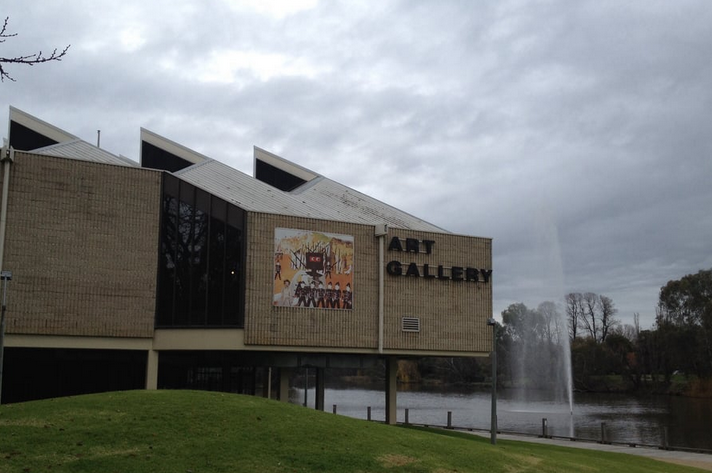
Australia has, in addition to the major state public art galleries in the capital cities, a network of smaller public art galleries in regional centres throughout the Commonwealth. Some of these, such as the Ballarat Art Gallery, are very long established—in that case a product of the gold boom in Victoria. Others have been the result of later cultural initiatives by local communities and far-sighted private individuals. In the case of Victoria, as Don Edgar’s useful 2019 book Art for the Country: The Story of Victoria’s Regional Art Galleries has made clear, there were also strong state government programs to encourage and part-fund establishment of such regional galleries, especially from the 1950s onwards.
This essay appears in the latest Quadrant.
Click here to subscribe
The foundation of the Benalla Art Gallery (above), and its opening in 1975 in its own purpose-built building beside the lake in the botanical gardens, were a special example of the advances made in this field. A recent visit to the gallery has been the occasion to review the merits of this important regional gallery.
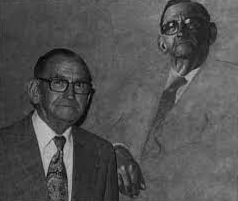 The story of the establishment of the Benalla Art Gallery has been well told by Dr Edgar in his book. It was the product of a fine joint effort between various individuals, chief amongst whom was the late Laurence Ledger, businessman, farmer, stock and station agent, and art connoisseur. He was encouraged by that remarkable figure in Mildura and Victorian political life Reginald Etherington (right, with his portrait), who as a councillor and sometime mayor of Mildura had a major role in the Victorian Regional Galleries Group from 1957 onwards.
The story of the establishment of the Benalla Art Gallery has been well told by Dr Edgar in his book. It was the product of a fine joint effort between various individuals, chief amongst whom was the late Laurence Ledger, businessman, farmer, stock and station agent, and art connoisseur. He was encouraged by that remarkable figure in Mildura and Victorian political life Reginald Etherington (right, with his portrait), who as a councillor and sometime mayor of Mildura had a major role in the Victorian Regional Galleries Group from 1957 onwards.
Laurie Ledger had acquired various artworks in a collection he had built up with the assistance of Paul Dwyer of Leonard Joels. He had some on display in his home and others hung “high up on the walls of a shed” which raised concerns for their safety against heat and damp. (One thinks here of the tragedy of the hundreds of pictures by Clarice Beckett which were lost when stored in a shed in Benalla where they became prey to possums! But that cultural disaster was not Laurie Ledger’s doing.) Etherington persuaded Ledger to persist with his plan to donate his collection to the Benalla Council and when the council’s reluctance almost turned Ledger off the idea, 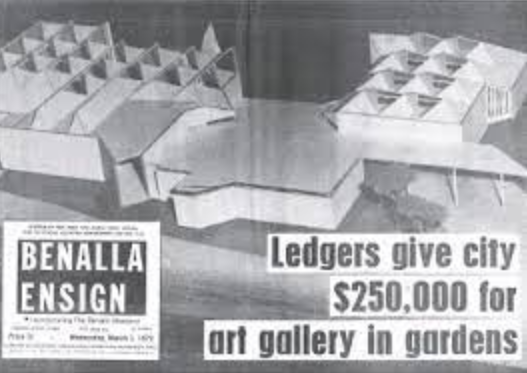 Etherington persuaded Ledger to also fund in great part, and with the benefit of state grants, the building of the Benalla Art Gallery, in conjunction with the redevelopment of the riverside lake project.
Etherington persuaded Ledger to also fund in great part, and with the benefit of state grants, the building of the Benalla Art Gallery, in conjunction with the redevelopment of the riverside lake project.
Today, while the gallery takes its place in the network of Australian regional galleries, it also remains a special and interesting case study. This is so both as to its founding—which resembled the familiar pattern of how such local galleries came into being, yet also partook of some special features—and also as to its development since 1975, when it has extended its collection to embrace many significant works of post-1968 Australian art.
The purpose here is to provide a brief outline of the Benalla Art Gallery’s collection at its lakeside setting and to give an idea of what to expect when you visit. I visited the gallery twice during April and May this year. It was a 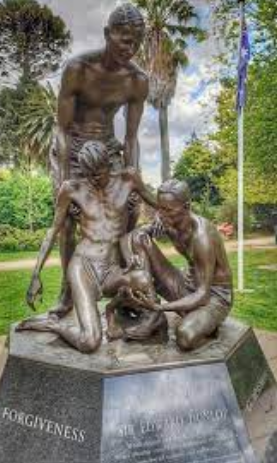 pleasure to find the gallery so well placed in relation to the commercial centre of Benalla and in its botanical gardens setting, where a large bronze (right) unveiled by former Prime Minister John Howard pays tribute to that distinguished son of Benalla, Sir Edward “Weary” Dunlop, surgeon, soldier and great humanitarian. My first visit came just after Anzac Day and it was at once poignant, telling and moving to see, near the gallery entry ramp, the large groupings of wreaths lately laid upon the cenotaph memorial to Benalla’s war dead: showing once again that in contrast to the outlook of many amongst the metropolitan elites, these regional communities have not forgotten and will never forget those sacrifices, come what may.
pleasure to find the gallery so well placed in relation to the commercial centre of Benalla and in its botanical gardens setting, where a large bronze (right) unveiled by former Prime Minister John Howard pays tribute to that distinguished son of Benalla, Sir Edward “Weary” Dunlop, surgeon, soldier and great humanitarian. My first visit came just after Anzac Day and it was at once poignant, telling and moving to see, near the gallery entry ramp, the large groupings of wreaths lately laid upon the cenotaph memorial to Benalla’s war dead: showing once again that in contrast to the outlook of many amongst the metropolitan elites, these regional communities have not forgotten and will never forget those sacrifices, come what may.
Indeed, it was in the immediate post-war period that Australia underwent the signal change in its attitude to art and cultural matters generally which was ultimately to result in the establishment of many regional galleries. There was an atmosphere of innovation and a growing new openness of approach. Various cultural and art historians have remarked upon the way in which periods of cultural and artistic efflorescence often follow fast upon the return of prosperity after periods of dearth, deprivation or wars. This was very much the case in Australia after 1945. One can almost date it from the ruckus and litigation over William Dobell’s Archibald Prize for his portrait of Joshua Smith in 1945-46, but that was just one marker. By the 1950s, the return 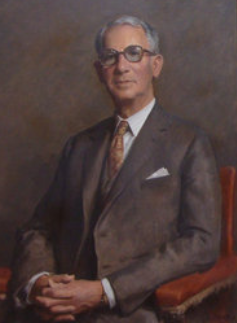 to a growing and developing economy led to a renewed desire to achieve in local government not merely roads, bridges, drains and sports fields but also schools, colleges, libraries, art galleries and cultural centres.
to a growing and developing economy led to a renewed desire to achieve in local government not merely roads, bridges, drains and sports fields but also schools, colleges, libraries, art galleries and cultural centres.
It was in this atmosphere that individuals of drive and energy like Ledger (left) and Etherington wanted the establishment art collections available to the public in the regions, just as for instance, Bill Bolton of Toowoomba was to do in forming and offering the public his collection of Australian art and books.
The collection and holdings of the Benalla Art Gallery are a great deal more in volume and quality than, uninformed, one might expect of a small city the size of Benalla. The Ledger Collection was the solid bedrock on which the gallery was formed and subsequently it has been augmented by the acquisition of further works of the post-1968 period. It therefore has a certain balance which is not always present in the collections of the regional galleries. Among Laurie Ledger’s benefactions, the following names indicate the sweep of his vision and the scope of the Ledger Collection and then also the further gains in the Bennett Collection: Tom Roberts, Arthur Streeton, Frederick McCubbin, Louis Buvelot, Girolamo Nerli, Eugene von Guerard, W.C. Piguenit, J.H. Scheltema, S.T. Gill, Clara Southern, Walter Withers, Emanuel Phillips Fox, David Davies, Rupert Bunny, John Peter Russell, George Lambert, Penleigh Boyd, Hans Heysen, Elioth Gruner, William Frater, Arnold Shore, William Dobell, Russell Drysdale, Sidney Nolan, Ethel Carrick Fox, Grace Cossington Smith, Margaret Preston, Lloyd Rees, Roland Wakelin, Eric Wilson, John Perceval and Fred Williams.
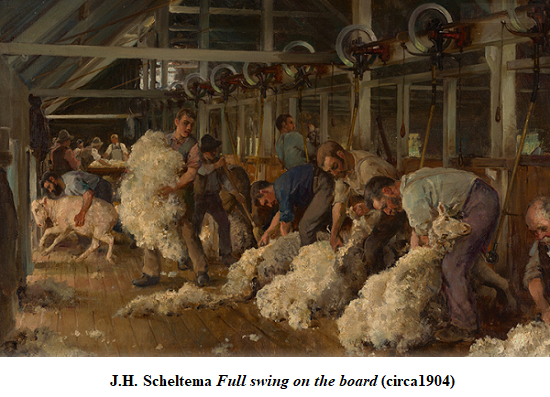
Yet these are merely some highlights, because the collection at Benalla also is so extensive as to include fine works by Max Meldrum, George Bell, Julian Ashton, Sir Will Ashton, Horace Brodzky, Roy de Maistre, Bernard Hall, J.J. Hilder, Norman Lindsay, Daryl Lindsay, Percy Lindsay, James R. Jackson, Nora Heysen, Lorna Chick, Jean Bellette, Robert Johnson, Rubery Bennett, Charles Blackman, Michael Kmit, Albert Tucker, Desiderius Orban, Hugh Ramsay, H.S. Power, B.E. Minns, A.E. Newbury, W.B. McInnes, Sydney Long, Kathleen O’Connor, Adelaide Perry, Freda Robertshaw, Ethel Spowers, Grace Crowley, Thea Proctor, Clarice Beckett, Peter Purves-Smith, Adrian Lawlor, Danila Vassilieff, Lina Bryans and Charles Wheeler, amongst others. This is a roll-call that reminds one of the scope of the Hinton Collection in the New England Regional Art Museum at Armidale. For these alone, one would find a trip to Benalla to see them a sufficient reward. Yet there is more.
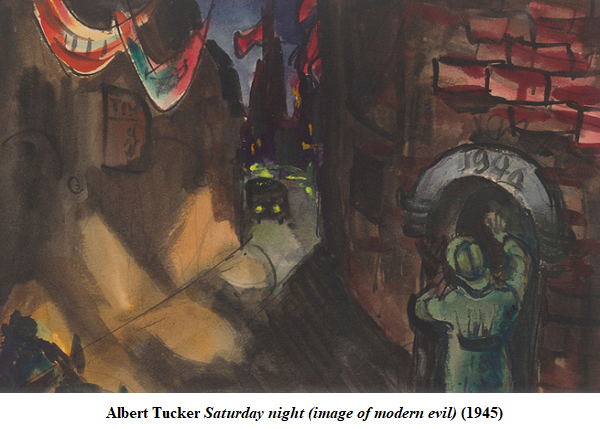
The gallery’s collection has been extended in its scope, coverage and appeal by the inclusion of works of the post-1960 period such as those by Thomas de Kessler, Sydney Ball, John Brack, Arthur Boyd, Rosalie Gascoigne, Janet Dawson, Bea Maddock, Dick Watkins, Richard Larter, Ivan Durrant (who was born in Benalla), Peter Booth, Ronnie Tjampitjinpa, Tom Johnson, Brett Whiteley, Mike Parr, Juan Davila, Rover Thomas, Gloria 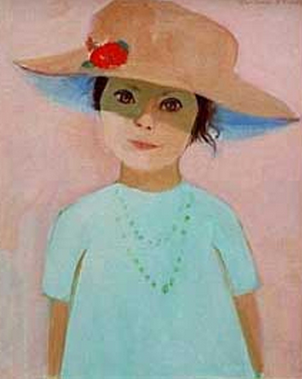 Tamerre Petyarre and William Robinson, amongst others. In this way, successive boards of trustees and directors have duly built bridges which link the foundational Ledger Collection in its representative art-historical significance, with a collection of significant later and contemporary works. It was particularly pleasing to see, exhibited in the main gallery, Constance Stokes’s delightful portrait (right) of her young grand-daughter, Isabella, painted in about 1985.
Tamerre Petyarre and William Robinson, amongst others. In this way, successive boards of trustees and directors have duly built bridges which link the foundational Ledger Collection in its representative art-historical significance, with a collection of significant later and contemporary works. It was particularly pleasing to see, exhibited in the main gallery, Constance Stokes’s delightful portrait (right) of her young grand-daughter, Isabella, painted in about 1985.
Like most regional galleries, the Benalla Art Gallery has special exhibition spaces available for exhibitions of post-1968 works including contemporary works of art. During my second visit to the gallery, the current special exhibition was a large grouping of works by the painter Robert Jacks.
During my visit I was able, in addition to seeing in the main collection’s current exhibition a selection from the range of works by the above artists, to also have a viewing of a small selection of choice works from storage. I had asked specially to see these, not only for their interest in themselves, but also because they are works by a small group of artists who stand in a special way for key transitional periods and latterly, for the emergence and acceptance of Modernism in art in Australia. These are Ethel Carrick Fox, John Peter Russell, William Frater and Arnold Shore, as well as Lloyd Rees.
Ethel Carrick Fox’s small oil In the Luxembourg Gardens (c. 1910) is an exquisite picture with all of the painter’s trademark vivacity and freshness of colour, combined with her particular take on the impressionist mode or style of work. Ledger was fortunate to obtain this highly representative work and it may be termed one of the gems of the Benalla collection.
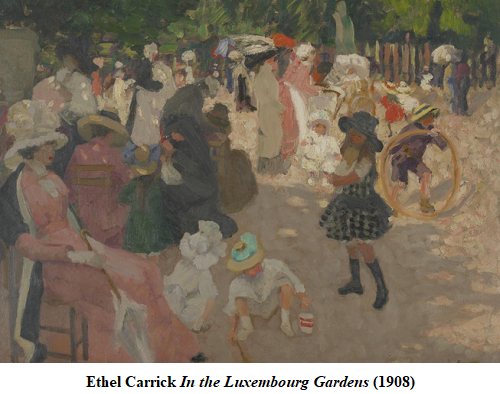
Next was Ile de la Jatte a Neuilly (1889) one of three works at the gallery by John Peter Russell, the Australian who was a good friend of Monet’s and painted many works in Brittany. This Russell work is striking in the purple tones of a stand of trees at its centre, seen across a stretch of water rendered in the artist’s distinctive almost scumbled but layered manner, against a sky enlivened by pinks, whites and blue. It is a strong composition and is very evocative of Russell’s long sojourn in France. Russell, for long relatively neglected, gradually gained acceptance and became much sought after by major Australian collectors such as Sir Leon and Lady Trout of Brisbane, and it is only a little while ago that Russell’s works enjoyed a large exhibition in Sydney. For a regional gallery like Benalla to have one of his French works is another feather in its cap and this, like the Carrick Fox and another work done in Paris by that superb Australian artist Kathleen O’Connor (The Luxembourg Gardens, c. 1910/1914) goes to show the importance of the direct exposure of our Australian artists to the styles of the School of Paris at that important period in art.
The next group of pictures included a pleasing holding of William Frater oils. These were a Victorian countryside landscape, Near Whittlesea (1960s), and one of Frater’s famous Central Australia series of views done in the early 1950s. The latter is a most satisfying work of particular warmth and richness, where Frater delights in using the Cezannesque “apricot palette” which so featured in some of his best work during the 1950s. Works like these prompted the late Laurie Thomas to comment about Frater that with his use of greys, soft greens and pinks, the artist achieved a resultant effect that was “not just right, but dead right” to coin an Australian phrase. There was also a fine portrait by Frater, The Senorita, which is one of his most successful examples, for his portrayals could sometimes become looser. This one is sharply delineated and the choice of colours in the dress against the background colours is very fetching indeed. It is closer to the magic of his great portrait of Lina Bryans, The Red Hat (1937, NGV) than some of his lesser and later portraits.
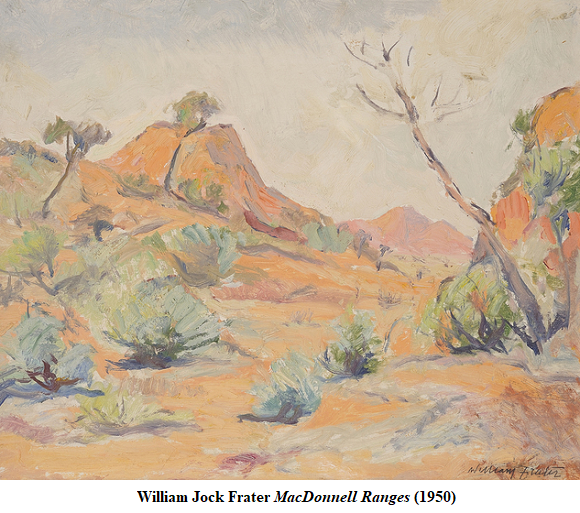
From some fine examples I have seen, still held in private hands, we as yet lack an overall appreciation of Frater’s considerable skill in portraiture: and this picture at Benalla is important evidence of that. As the years go by, when more of these works reach the market and galleries, it is my view there will be a further positive re-appraisal of this important Scottish-Australian artist, who was our main link with the Scottish Colourist movement. Dick Wittman’s book on Frater, reviewed in these pages some time ago, has provided an enormously improved understanding of Frater’s achievements. The remaining Frater work was a large oil of some figures in an interior, Mario’s Club Restaurant, executed in the late 1950s or early 1960s. It has the effect of a sketch, and some of the 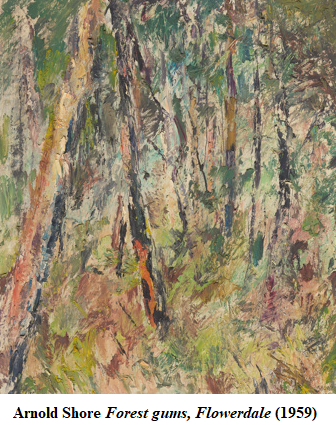 faces are blank and unfinished (one thinks, momentarily, of the category of “former persons” in the old Soviet bloc) but it is a coherent work which expresses the lively scene of a dance-floor and dining area with its habitués enjoying themselves in a most urbane fashion. It is done in a combination of blacks, browns and skin tones, unlike other brighter Fraters, but no doubt accurately expressing the night-time mood of the venue.
faces are blank and unfinished (one thinks, momentarily, of the category of “former persons” in the old Soviet bloc) but it is a coherent work which expresses the lively scene of a dance-floor and dining area with its habitués enjoying themselves in a most urbane fashion. It is done in a combination of blacks, browns and skin tones, unlike other brighter Fraters, but no doubt accurately expressing the night-time mood of the venue.
The next-to-last picture brought out for us was Arnold Shore’s Forest Gums, Flowerdale (1959) which is illustrated in colour in Rob Haysom’s major monograph on Shore. As Dr Haysom’s book indicates, Arnold Shore’s works are very special in that he was an Australian artist who regrettably, because of his straitened personal circumstances for nearly all his life, never managed to view any art outside Australia, yet his final style is always a revelation to come upon, achieving a mode of expression for the Australian bush which very much anticipates what his sometime pupil Fred Williams was to develop later. The Benalla gallery also possesses a striking and beautiful flower piece by Arnold Shore, Magnolias (1933).
The last picture viewed was Lloyd Rees’s superb view River at Richmond (1968) which carries us back again to that wonderful period in the late 1960s, when Rees had not yet developed his late diffuse and luminous style, but was painting with that particular amalgam of monumentality and spontaneity which characterised some of his best work. This picture is a good example of that and once again, it is Benalla’s great fortune to have this colourful and representative work by Lloyd Rees, who became both the Grand Old Man of Australian Art in his later years, and was also perhaps Australia’s most loved artist in the last half of his own century.
The experiences of my visits to the Benalla Art Gallery were fruitful. I came away gladdened that this small city holds such treasures as it does. Those I have pointed out here are but a fraction of what is on offer in the Ledger and Bennett and wider collections at this regional gallery.
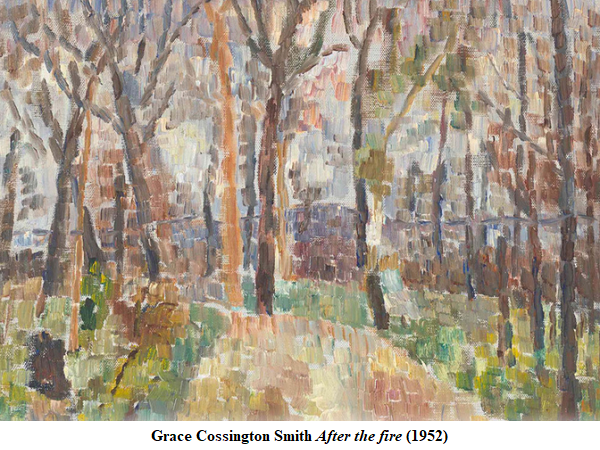
Before concluding, I should mention some other artists represented in the collections who are of great importance for the history of art in Australia, such as the Cavalier Antonio Dattilo-Rubbo, whose school at Sydney was significant for the encouragement he gave painters such as Grace Cossington Smith. And there are many others, such as Ada May Plante, Arthur Murch, Justin O’Brien, Albert Namatjira, William Lister Lister and George Lawrence who likewise are represented in the trove of good things at Benalla Art Gallery.
Given that the current public health situation due to the Covid virus is preventing Australians from seeing first-hand the great artworks in international art galleries and museums, it is to be hoped that galleries in Australia, both metropolitan and regional, will be enabled and funded so as to be able to make the most of what we hold here at home and to give more public exposure to works in their permanent collections. We underestimate what can be made of our regional collections.
Douglas Hassall adds: I wish to thank the Director of the Benalla Art Gallery, Mr Eric Nash, and Ms Annabelle Williams on the gallery staff for their kind assistance, which facilitated this article by welcoming my visit and arranging for me to view the works discussed above. I am also grateful to Ms Sue McKay of Clement House in Benalla for information about the late Laurence Ledger and his collecting of Australian art.
Dr Hassall, a frequent contributor, wrote on the art patronage of Prince Philip in the June issue
 Sign In
Sign In 0 Items (
0 Items ( Search
Search










Thank you for your excellent article. My wife and I are now fired up to tour Victoria’s galleries while we have the freedom to travel.